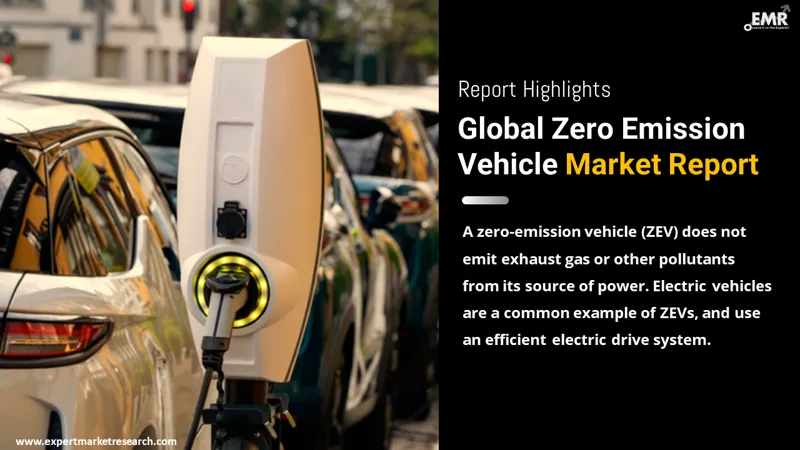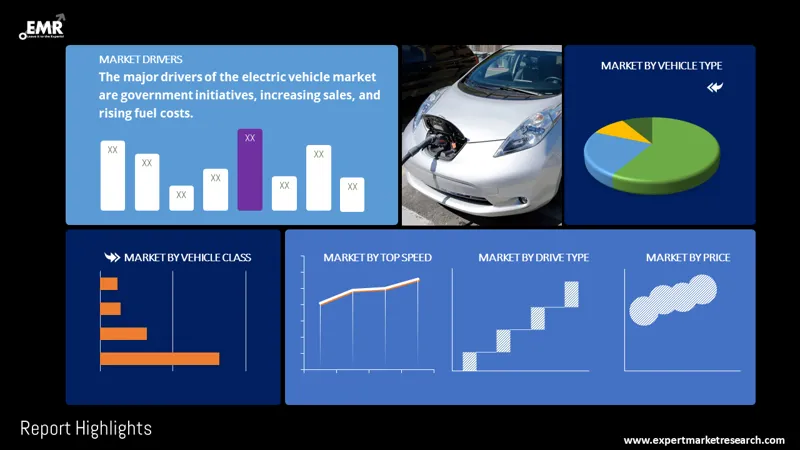
Consumer Insights
Uncover trends and behaviors shaping consumer choices today
Procurement Insights
Optimize your sourcing strategy with key market data
Industry Stats
Stay ahead with the latest trends and market analysis.
The global zero emission vehicle market size attained a value of USD 427.08 Billion in 2025. The market is further expected to grow at a CAGR of 23.90% between 2026 and 2035, reaching a value of USD 3641.01 Billion by 2035.
Base Year
Historical Period
Forecast Period
Compound Annual Growth Rate
23.9%
Value in USD Billion
2026-2035
*this image is indicative*
| Global Zero Emission Vehicle Market Report Summary | Description | Value |
| Base Year | USD Billion | 2025 |
| Historical Period | USD Billion | 2019-2025 |
| Forecast Period | USD Billion | 2026-2035 |
| Market Size 2025 | USD Billion | 427.08 |
| Market Size 2035 | USD Billion | 3641.01 |
| CAGR 2019-2025 | Percentage | XX% |
| CAGR 2026-2035 | Percentage | 23.90% |
| CAGR 2026-2035 - Market by Region | Asia Pacific | 28.7% |
| CAGR 2026-2035 - Market by Country | India | 30.1% |
| CAGR 2026-2035 - Market by Country | Canada | 27.9% |
| CAGR 2026-2035 - Market by Vehicle Type | Battery Electric Vehicle (BEV) | 26.3% |
| CAGR 2026-2035 - Market by Vehicle Class | Passenger Cars | 26.8% |
A zero emission vehicle, or ZEV, refers to a type of vehicle which does not emit exhaust gas or other contaminating pollutants, from its source of power. Electric vehicles are a common example of ZEV, and use an efficient electric drive system. These vehicles are integrated with high voltage storage batteries and a high-speed charging system which facilitates electrified propulsion for the vehicle.

Read more about this report - REQUEST FREE SAMPLE COPY IN PDF
Global Zero Emission Vehicle Market Report and Forecast 2026-2035 offers a detailed analysis of the market based on the following segments:
Breakup by Vehicle Type
Breakup by Vehicle Class
Breakup by Price
Breakup by Drive Type
Breakup by Top Speed
Breakup by Region

Read more about this report - REQUEST FREE SAMPLE COPY IN PDF
The battery electric vehicle (BEV) segment, based on vehicle type, accounts for a sizable share of the zero emission vehicle (ZEV) market. Growing eco-consciousness among consumers, coupled with the increasing fuel prices across developed and developing economies is leading to a transition from conventional to battery electric vehicles. In addition, lower maintenance cost and tax and financial benefits offered by battery electric vehicles are further heightening their adoption among urban populations.
Based on region, Asia Pacific is projected to witness significant growth in the market for zero emission vehicles. Emerging economies such as India and China are supporting the growth of the emerging vehicle electrification ecosystem in the Asia Pacific, leading to a greater sale of zero emission vehicles. In addition, rising greenhouse emissions from the transportation sector is leading to various governments encouraging electrification of transportation, which in turn is likely to aid the zero emission vehicle (ZEV) market in this region in the coming years.
| CAGR 2026-2035 - Market by | Country |
| India | 30.1% |
| Canada | 27.9% |
| China | 25.2% |
| USA | 24.1% |
| Australia | 19.5% |
| Japan | 17.1% |
| UK | XX% |
| Germany | XX% |
| France | XX% |
| Italy | XX% |
| Saudi Arabia | XX% |
| Brazil | XX% |
| Mexico | XX% |
The comprehensive EMR report provides an in-depth assessment of the market based on the Porter's five forces model along with giving a SWOT analysis. The report gives a detailed analysis of the key players in the global zero emission vehicle market, covering their competitive landscape and latest developments like mergers, acquisitions, investments and expansion plans.
Hyundai Motor Company is a multinational automobile manufacturer which was founded in 1967 and is currently headquartered in Seoul, South Korea. The company is known to produce some of the most popular motor vehicles used across the globe.
Fiat Automobiles S.p.A is a leading automobile manufacturing company which pursues fast development of fully electric vehicles. Founded in 1899 and headquartered in Turin, Italy, this company markets and sells high-end automobiles.
BYD Co. Ltd. is a leading conglomerate company which designs, sells, and manufactures rechargeable batteries, photovoltaic products, and handset components, among others. It was founded in 1995 and is headquartered in Shenzhen, China.
*Please note that this is only a partial list; the complete list of key players is available in the full report. Additionally, the list of key players can be customized to better suit your needs.*
Other market players include Tesla, Inc., Ford Motor Company, BMW AG, Toyota Motor Co., Ltd., Nissan Motor Co., Ltd., Volkswagen AG, and Tata Motors Limited, among others.




*While we strive to always give you current and accurate information, the numbers depicted on the website are indicative and may differ from the actual numbers in the main report. At Expert Market Research, we aim to bring you the latest insights and trends in the market. Using our analyses and forecasts, stakeholders can understand the market dynamics, navigate challenges, and capitalize on opportunities to make data-driven strategic decisions.*
Get in touch with us for a customized solution tailored to your unique requirements and save upto 35%!
The market reached a value of USD 427.08 Billion in 2025.
The market is estimated to grow at a CAGR of 23.90% between 2026 and 2035.
The market is estimated to witness a healthy growth in the forecast period of 2026-2035 to reach a value of USD 3641.01 Billion by 2035.
The favourable initiatives of governments to reduce vehicular pollution, increasing sale of light and heavy-duty electric vehicles, and rising expenses of traditional fuel-based vehicles are the major drivers of the market.
The key trends in the market include the growing investments towards research and innovation by the major automotive manufacturers, reducing costs of electric vehicles, and growing eco-consciousness among users.
Passenger cars, commercial vehicles, and two wheelers are the different vehicle classes of zero emission vehicles in the market.
Front-wheel drive, rear-wheel drive, and all-wheel drive are the significant drive types of zero emission vehicles in the market.
BYD Co. Ltd., Tesla, Inc., Hyundai Motor Company, Ford Motor Company, Fiat Automobiles S.p.A, BMW AG, Toyota Motor Co., Ltd., Nissan Motor Co., Ltd., Volkswagen AG, and Tata Motors Limited, among others, are the key market players, according to the report.
Explore our key highlights of the report and gain a concise overview of key findings, trends, and actionable insights that will empower your strategic decisions.
| REPORT FEATURES | DETAILS |
| Base Year | 2025 |
| Historical Period | 2019-2025 |
| Forecast Period | 2026-2035 |
| Scope of the Report |
Historical and Forecast Trends, Industry Drivers and Constraints, Historical and Forecast Market Analysis by Segment:
|
| Breakup by Vehicle Type |
|
| Breakup by Vehicle Class |
|
| Breakup by Price |
|
| Breakup by Drive Type |
|
| Breakup by Top Speed |
|
| Breakup by Region |
|
| Market Dynamics |
|
| Competitive Landscape |
|
| Companies Covered |
|
Datasheet
One User
USD 2,499
USD 2,249
tax inclusive*
Single User License
One User
USD 3,999
USD 3,599
tax inclusive*
Five User License
Five User
USD 4,999
USD 4,249
tax inclusive*
Corporate License
Unlimited Users
USD 5,999
USD 5,099
tax inclusive*
*Please note that the prices mentioned below are starting prices for each bundle type. Kindly contact our team for further details.*
Flash Bundle
Small Business Bundle
Growth Bundle
Enterprise Bundle
*Please note that the prices mentioned below are starting prices for each bundle type. Kindly contact our team for further details.*
Flash Bundle
Number of Reports: 3
20%
tax inclusive*
Small Business Bundle
Number of Reports: 5
25%
tax inclusive*
Growth Bundle
Number of Reports: 8
30%
tax inclusive*
Enterprise Bundle
Number of Reports: 10
35%
tax inclusive*
How To Order

Select License Type
Choose the right license for your needs and access rights.

Click on ‘Buy Now’
Add the report to your cart with one click and proceed to register.

Select Mode of Payment
Choose a payment option for a secure checkout. You will be redirected accordingly.
Gain insights to stay ahead and seize opportunities.

Get insights & trends for a competitive edge.

Track prices with detailed trend reports.

Analyse trade data for supply chain insights.

Leverage cost reports for smart savings

Enhance supply chain with partnerships.

Connect For More Information
Our expert team of analysts will offer full support and resolve any queries regarding the report, before and after the purchase.
Our expert team of analysts will offer full support and resolve any queries regarding the report, before and after the purchase.
We employ meticulous research methods, blending advanced analytics and expert insights to deliver accurate, actionable industry intelligence, staying ahead of competitors.
Our skilled analysts offer unparalleled competitive advantage with detailed insights on current and emerging markets, ensuring your strategic edge.
We offer an in-depth yet simplified presentation of industry insights and analysis to meet your specific requirements effectively.
Share